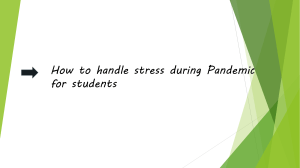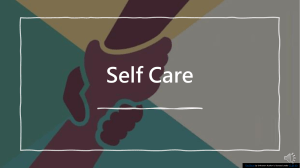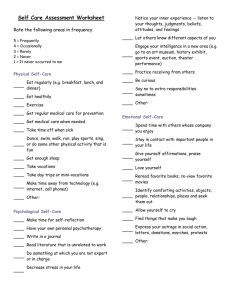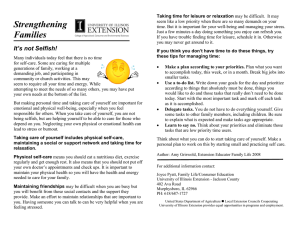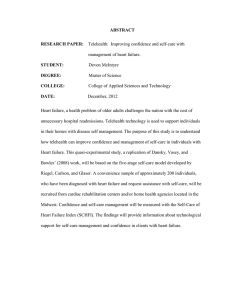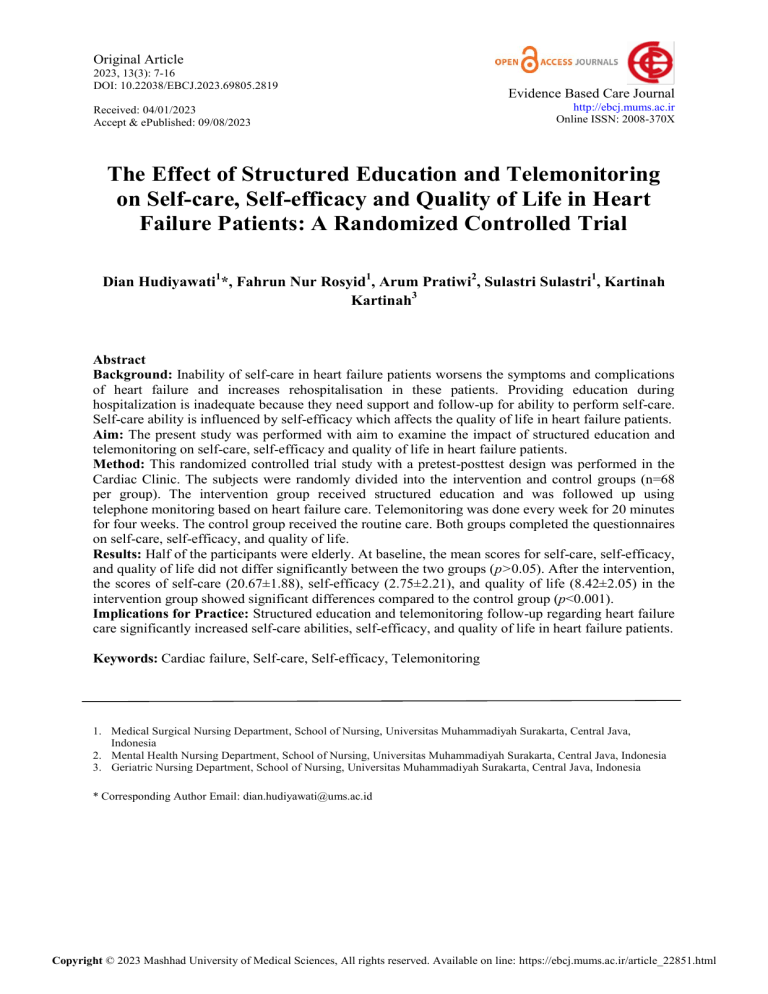
Original Article 2023, 13(3): 7-16 DOI: 10.22038/EBCJ.2023.69805.2819 Received: 04/01/2023 Accept & ePublished: 09/08/2023 Evidence Based Care Journal http://ebcj.mums.ac.ir Online ISSN: 2008-370X The Effect of Structured Education and Telemonitoring on Self-care, Self-efficacy and Quality of Life in Heart Failure Patients: A Randomized Controlled Trial Dian Hudiyawati1*, Fahrun Nur Rosyid1, Arum Pratiwi2, Sulastri Sulastri1, Kartinah Kartinah3 Abstract Background: Inability of self-care in heart failure patients worsens the symptoms and complications of heart failure and increases rehospitalisation in these patients. Providing education during hospitalization is inadequate because they need support and follow-up for ability to perform self-care. Self-care ability is influenced by self-efficacy which affects the quality of life in heart failure patients. Aim: The present study was performed with aim to examine the impact of structured education and telemonitoring on self-care, self-efficacy and quality of life in heart failure patients. Method: This randomized controlled trial study with a pretest-posttest design was performed in the Cardiac Clinic. The subjects were randomly divided into the intervention and control groups (n=68 per group). The intervention group received structured education and was followed up using telephone monitoring based on heart failure care. Telemonitoring was done every week for 20 minutes for four weeks. The control group received the routine care. Both groups completed the questionnaires on self-care, self-efficacy, and quality of life. Results: Half of the participants were elderly. At baseline, the mean scores for self-care, self-efficacy, and quality of life did not differ significantly between the two groups (p>0.05). After the intervention, the scores of self-care (20.67±1.88), self-efficacy (2.75±2.21), and quality of life (8.42±2.05) in the intervention group showed significant differences compared to the control group (p<0.001). Implications for Practice: Structured education and telemonitoring follow-up regarding heart failure care significantly increased self-care abilities, self-efficacy, and quality of life in heart failure patients. Keywords: Cardiac failure, Self-care, Self-efficacy, Telemonitoring 1. Medical Surgical Nursing Department, School of Nursing, Universitas Muhammadiyah Surakarta, Central Java, Indonesia 2. Mental Health Nursing Department, School of Nursing, Universitas Muhammadiyah Surakarta, Central Java, Indonesia 3. Geriatric Nursing Department, School of Nursing, Universitas Muhammadiyah Surakarta, Central Java, Indonesia * Corresponding Author Email: dian.hudiyawati@ums.ac.id Copyright © 2023 Mashhad University of Medical Sciences, All rights reserved. Available on line: https://ebcj.mums.ac.ir/article_22851.html Hudiyawati et al. Education and telemonitoring in heart failure 8 Introduction One of the most common diseases, particularly among the elderly, is heart failure. The rate of heart failure is increasing due to aging population; therapeutic advancements raise the survival rate of heart disease patients. Heart failure is a chronic disorder characterized by a progressive deterioration in the health (1,2). It is estimated that 38 million people in the world have heart failure. Roger in a study reported that the prevalence of heart failure ranged from 1-12% in the adult population in the United States and Europe. The prevalence of heart failure is projected to continue rising until 2030 due to the increasing rate of elderly population (3). Based on data from the Indonesian Ministry of Health, the incidence of heart failure in 2018 was 1.5%, or around 29,880 people (4). Heart failure is a chronic disease often associated with high morbidity and mortality rate, high healthcare costs, low quality of life, and high rehospitalization rates (5). Chronic heart failure requires long-term and complex treatment, which can cause patients not to be confident and less capable of managing their illness. So, the ability of self-care in heart failure patients is one of the main predictors of achieving optimal health outcomes. Self-care is vital in dealing with chronic health problems, including heart failure. Self-care is closely related to how patients manage their health conditions, can maintain physical function abilities and can achieve well-being (6). The results of previous studies indicated that the inability of self-care in heart failure patients is still a major challenge which worsens heart failure symptoms, complications, and rehospitalization (7). The patient's quality of life is also affected by poor self-care. However, age will also affect the patient's quality of life. The study by Osipova et al. found that heart failure patients in the elderly show poor quality of life compared to younger age (8). Another factor affecting self-care ability is the level of self-confidence. Seid et al. in their study (2012) stated that a person's self-confidence would affect the appearance of self-care aspects (9). Hudiyawati et al. also described that self-care and selfefficacy have a positive correlation which is interrelated (10). Several interventions have been attempted in patients with heart failure, such as providing education during hospitalization and discharge; however, it was inadequate because patients need support and follow-up for ability to perform self-care (11). Strategies implemented to facilitate patient care after hospital discharge still need to be improved. Furthermore, due to the geographic distribution of patients, long travel distances, the time required, lack of resources and costs, and the current conditions of the Covid 19 pandemic, it is difficult to provide health support for heart failure patients after discharge (12). Educational methods to improve self-care in patients with heart failure have been implemented in hospitals in Indonesia, such as giving leaflets with oral education by health workers during health controls. This education has yet to show optimal results. Patients don't understand what to do in selfcare, so they do not know how to practice self-care for heart failure. They also often feel insecure in the independent care (13,14). Therefore, other methods are needed to educate and monitor heart failure patients to increase confidence in performing self-care. Monitoring by telephone (telemonitoring) is a method that utilizes remote monitoring, which can be done anytime and wherever. Self-care monitoring by telephone is cheaper and more flexible. Previous studies indicated that telemonitoring could change patient's behavior to improve self-care and quality of life (15). A study by Demircelik et al. explained that telemonitoring-based method in heart failure patients could improve their psychological, emotional, and quality of life (16). In line with that statement, behavior change theory showed that increasing self-efficacy could support adequate self-care for a patient (17). Telemonitoring is crucial to help patients provide independent care at home. According to a prior study by Negarandeh and colleagues, telemonitoring improved clinical outcomes, including lower mortality, rehospitalization, and quality of life in heart failure patients (12). Telemonitoring uses information and communication technologies to provide accurate and current data or education. As a result, patients would better understand the actual progression of their health conditions and are more comfortable to conduct independent care at home. Telemonitoring can utilize diverse media, including audio, video, and other communication technologies to remotely monitor, support, and educate patients (18). Literature search indicates that most telemonitoring approaches were conducted in Western countries with high incomes and highly educated populations. To the authors' knowledge, the evidence regarding the impact of telemonitoring on self-care, self-efficacy, and quality of life in heart failure patients is not well documented. Therefore, the present study was performed with aim to examine the impact of structured education and telemonitoring on self-care, self-efficacy and quality of life in heart failure patients. Copyright © 2023 Mashhad University of Medical Sciences, All rights reserved. Available on line: https://ebcj.mums.ac.ir/article_22851.html 9 Evidence Based Care Journal. 2023, 13 (3): 7-16 Methods This quantitative single-blind randomized controlled trial study with a pretest-posttest design was conducted on heart failure patients in the cardiac outpatient clinic at Dr. Moewardi Hospital Surakarta in January 2022. The sample size was determined based on the estimated participants size to compare the means of the two independent groups in previous studies (19). The minimum sample size required for each group was 32 subjects. Therefore, to avoid attrition and to strengthen the effect size, the study sample size was increased to 68 subjects per group. The sampling technique was simple randomization. Participants were randomly divided into two groups: the intervention group (received telemonitoring) and the control group (received routine care of the hospital). The randomization method was the research randomizer application (randomizer.org) to determine the intervention or control group, and random sequences were obtained for the intervention and control groups. The sequence implied that the numbers 1-136 were the order of the control and intervention groups. The researchers sorted the participants who were met daily, established the sequence in which they were met, and then decided whether they will be placed in the intervention or control group. All participants were blind about the type of group they were placed. Participants were selected based on predetermined inclusion criteria, including heart failure patients with the New York Heart Association (NYHA) functional class II and III categories, and age over 45 years, having a smartphone, not suffering from hearing loss, no physical limitation in self-care, also not suffering from mental disorder. Exclusion criteria were heart failure patients who were re-hospitalized and died. Among 141 patients who were eligible to participate and had been randomly assigned to either the intervention or control group, 5 cases were lost to follow-up (three from the intervention group and two from the control group). Therefore, data analysis was conducted on 136 participants (68 per group) (Figure 1). Assessed for eligibility (n= 143) Excluded (n= 2) Due to refuse to participate (n=2) Randomized (n= 141) Allocated to intervention (n=71) Allocated to control (n=70) Lost to follow-up (n=5) Lost to follow up (n=3) Due to not answer to next calling (n=3) Analyzed in the intervention group (n=68) Lost to follow up (n=2) Due to not answer to next calling (n=2) Analyzed in the control group (n=68) Figure 1. Consort Flow Diagram of the Study Protocol Copyright © 2023 Mashhad University of Medical Sciences, All rights reserved. Available on line: https://ebcj.mums.ac.ir/article_22851.html Hudiyawati et al. Education and telemonitoring in heart failure 10 The study team prepared educational material based on heart failure care theories that cardiologists reviewed and approved during the pre-intervention stage. Furthermore, the content was developed into an e-booklet as an educational tool. All participants in both the intervention and control groups, who had previously signed informed permission forms, completed the questionnaires of demographics, self-care, self-efficacy, and quality of life as pre-test scores. The intervention group received structured education on heart failure self-care (face-to-face training) in the cardiac outpatient clinic. Then, the participants were followed up with a telephone call once a week for 20 minutes for four consecutive weeks. The research team conducted telemonitoring in the intervention group with the assistance of nursing students who had similar views towards self-monitoring. During telemonitoring, the following information was obtained: the patient's condition during the previous week, such as perceived signs and symptoms of heart failure, the participants' compliance with drug consumption, barriers during self-care at home, activities, and eating patterns. At the end of the intervention, participants completed the post-test questionnaire. The participants responded to the questionnaire using Google Forms. The control group received heart failure education and consultation following hospital protocol, specifically during cardiac polyclinic monitoring. The participants in the control group did not receive weekly follow-ups. As a post-test, the researcher contacted participants at the end of the intervention to complete the questionnaire via the Google form. The tools used in this study included the questionnaire of the demographic characteristics including age, gender, marital status, education level, occupation, smoking history, length of disease, NYHA functional class, and comorbid disease. Also, the Indonesian version of the Self Care Heart Failure Index (SCHFI) was used to examine the self-care behavior of participants. The validity and reliability of the Indonesian version of the SCHFI have been evaluated with Cronbach alpha 0.83, and the results indicate that the questionnaire is valid and reliable as a measuring instrument. This questionnaire contains 22 questions with three scales that 10 questions are related to the self-care maintenance, 6 questions to the self-care management, and 6 questions to the self-care confidence. The total score ranged from 20 to 80 with a higher score indicating a better self-care (20). The Cardiac Self-Efficacy scale (CSE) was also used to measure self-efficacy. CSE consists of 13 questions which are scored on a 5-point Likert scale (0=not at all, 1=somewhat confident, 2=moderately confident, 3=very confident, 4=completely confident). CSE consists of two dimensions: symptom control with eight questions and function maintenance with five questions. CSE had great internal consistency as determined by Cronbach alpha (0.90 and 0.87, respectively) and good validity (21). In addition, the Minnesota Living with Heart Failure Questionnaire (MLHFQ) was used to assess the quality of life of heart failure patients in physical, psychological, and social aspects. The MLHFQ is a 21-item diseasespecific instrument for patients with heart failure. Each item is scored in a 6-point Likert Scale (0 to 5), thus the total score could range from 0 to 105, with higher scores indicating more significant impairment in health-related quality of life. The Indonesian version of MLHFQ is valid and reliable for assessing the quality of life in heart failure patients. It has a moderate to strong correlation between items in the questionnaire (r: 0.571-0.748; p<0.001) with a Cronbach alpha of 0.887 (22). Data were analyzed by SPSS software (version 20) and descriptive statistics, including frequency tables, central tendency, Chi-square test, Paired t-test, and Independent t-test. The demographic characteristics of the two groups were compared using Chi-square test. Kolmogorov-Smirnov test was applied to check the normal distribution of data. Paired t-test and Wilcoxon test were used for intragroup comparison of mean scores of self-care, self-efficacy, and quality of life before and after the intervention. A difference in mean between the groups was evaluated using the Independent t-test. P<0.05 was considered statistically significant. Results This study included 136 participants (75 male and 61 female). The demographic and disease features, including gender, age, educational level, job, smoking behavior, comorbid, length of the disease and the severity of the disease were presented in Table 1. The findings of the study indicated that age, comorbid diseases, and length of the disease showed a significant difference between the two groups (p<0.05). However, other demographic and disease characteristics of the two groups were not significantly different. As a result, the intervention and control groups shared the same characteristics (Table 1). Copyright © 2023 Mashhad University of Medical Sciences, All rights reserved. Available on line: https://ebcj.mums.ac.ir/article_22851.html 11 Evidence Based Care Journal. 2023, 13 (3): 7-16 Table 1. Demographic characteristics and disease features of heart failure patients Intervention group Characteristics Gender Male Female Age (yr) 17-35 36-55 >56 Level of education Elemntary school High school University Job status Unemployed Employed History of smoking Yes No Comorbid disease Hypertension Diabetes Mellitus Others No comorbid Length of disease (yr) <5 >5 NYHA Functional class NYHA II NYHA III * Chi-square test Control group P- value* Frequency (n) Percent (%) Frequency (n) Percent (%) 40 28 58.8 41.2 35 33 51.5 48.5 3 24 41 4.4 35.3 60.3 17 24 27 25 35.3 39.7 29 28 11 2.6 41.2 16.2 25 25 18 36.7 36.7 26.5 40 28 58.8 41.2 31 37 45.5 54.5 0.122 31 37 45.6 54.4 21 47 30.9 69.1 0.078 31 17 5 15 13.2 25 7.4 22.1 7 8 14 37 10.3 11.8 20.6 54.4 33 35 48.5 51.5 54 14 79.4 20.6 0.001 41 27 60.3 39.7 42 26 61.8 38.2 0.86 0.389 0.002 0.340 0.001 The intervention and control groups showed no statistically significant difference in self -care at baseline (p=0.222). However, there was a statistically significant difference between the two groups in mean self-care one month after the intervention (p<0.001). Although the control group showed decline in self-care (3.46±1.86), the intervention group had an increase in self-care (20.68±10.71) (Table 2). Before receiving the intervention, there was a significant difference between the intervention and control groups regarding mean self-efficacy (p=0.021). Furthermore, after one month of intervention, there was a statistically significant difference between the two groups in the mean self-efficacy (p<0.001). Mean self-efficacy increased in the intervention group (-2.75±2.97), while it decreased in the control group (5.368±2.95) (Table 2). There was not a statistically significant difference between the intervention and control groups in quality of life (QoL) score at baseline (p=0.284). However, after the intervention, there was a statistically significant difference between the two groups in the mean QoL (p<0.001). The intervention and control groups experienced a decrease in the mean quality of life (8.41±4.42) and (0.779±2.52), respectively. A higher quality of life might be indicated by a lower score on the quality of life score (Table 2). Copyright © 2023 Mashhad University of Medical Sciences, All rights reserved. Available on line: https://ebcj.mums.ac.ir/article_22851.html Hudiyawati et al. Education and telemonitoring in heart failure 12 Table 2. Analysis of the effect of education through telemonitoring on self-care, self-efficacy, and quality of life in heart failure patients Variables Pre-test Mean SD Post-test Self-care Intervention 57.68 7.76 Control 56.26 5.44 Intragroup comparison** 0.222 Self-efficacy Intervention 32.75 3.68 Control 31.51 2.32 Intragroup comparison** 0.021 Quality of life Intervention 44.43 4.80 Control 43.62 3.93 Intragroup comparison** 0.284 *Paired t-test, **Independent t-test Mean Difference Intragroup comparison* 78.35 7.11 52.81 5.31 0.001 -20.68 10.71 3.46 1.86 0.001 0.001 35.50 2.90 26.15 3.43 0.001 -2.75 2.97 5.368 2.95 0.001 0.001 36.01 2.73 42.84 3.198 0.001 8.41 4.42 0.779 2.52 0.001 0.013 Discussion The present study determined that educating patients through structured education and telephone monitoring has a statistically significant positive effect on patients' self-care, self-efficacy, and overall quality of life. In the telemonitoring group, there was a significant change in the mean self-care score which led to better self-care compared to the control group. The increasing mean self-care score of participants can be assumed to be due to the provision of education through the face-to-face training followed by telephone monitoring. The researchers believed that healthcare professionals are paying more attention to them and were more enthused that led to improve their self-efficacy. The result of the recent study was in line with the findings of Aamodt et al., who discovered that patients with heart failure prefer consultation and education through two-way interactions (23). The most common forms of two-way communication are face-to-face and telephone monitoring. Therefore, this method is relevant to the patients who are the majority of elderly, middle to lower socioeconomic levels, and low education levels. Allida et al. claimed that monitoring by health workers has a role in strengthening confidence in heart failure patients' ability to self-care and make decisions through selfcare activities (24). Other studies demonstrated that interaction with health professionals could reduce the incidence of re-hospitalization and mortality (25,26). These findings, together with those from prior research, imply that interaction with healthcare professionals was an excellent strategy to follow-up the patient in heart failure care (23). In line with the results of the current study, the research by Riley et al. showed that telemonitoring would help heart failure patients to develop selfcare skills to manage their condition (27). The study by Barnason and colleagues also demonstrated that the provision of structured and continuous education could effectively strengthen the self-care behavior of heart failure patients (28). Ding et al. also used telemonitoring to increase adherence to health management recommendations in the heart failure care. They found an increased level of patient's compliance, such as weighing regularly (29). In a study conducted by Abadi et al., providing face-to-face education and following up the patients after discharge significantly improved their lifestyle (30). The findings of the current study also indicated increased self-efficacy in the telemonitoring group after the intervention. According to this finding, educational methods involving face-to-face interaction followed by telephone monitoring can help increase self-efficacy to engage in heart failure self-care behaviors. The result of the present study is consistent with the self-efficacy theory, which indicates that the passage of time and opportunity for direct experience can improve self-confidence (31). Several investigations have demonstrated that self-efficacy influences self-care activities, including weight monitoring, medication adherence, physical activity, and diet compliance (10,32). Jiang et al. stated that patients with heart failure who attended nurse-led home-based therapy demonstrated improved self-efficacy which influenced their quality of life (33). In line with the finding of the present study, Boyne and colleagues conducted a tailored telemonitoring intervention in heart failure patients with a 6-month follow-up. Self-efficacy was measured using the Barnason Copyright © 2023 Mashhad University of Medical Sciences, All rights reserved. Available on line: https://ebcj.mums.ac.ir/article_22851.html 13 Evidence Based Care Journal. 2023, 13 (3): 7-16 Efficacy Expectation Scale, indicating 4.5% increase in self-efficacy scores. Therefore, telemonitoring intervention can increase self-efficacy (34). Education and promotion of health literacy can play a significant role in improving heart failure patients' health and optimizing their use of the health care system (35). The correlation test results between self-efficacy and self-care behavior conducted by Peyman et al. indicated a direct and significant association between the two variables after the intervention (36). Therefore, if there is a more significant improvement in mean self-efficacy scores, the difference in self-care scores will be significantly higher in the intervention group than in the control group. Consistent with these findings, Chen et al reported that an increase in self-efficacy would improve the self-care practices of heart failure patients (37). According to the findings of the present study, at the beginning of the study, the mean QoL scores revealed no significant differences between the two groups. Indeed, the QoL scores of the two groups were comparable. However, after the intervention, the mean QoL scores differed significantly. The experimental and control groups have seen a decline in their mean quality of life scores after the treatment, but the reduction in the experimental group was significantly more substantial. Confidentiality in heart failure patients' self-care is closely related to self-care behavior and patients' quality of life. Inadequate quality of life is a strong predictor of mortality and morbidity (38). Selfefficacy has a physical and psychological impact on heart failure patients' Health-Related Quality of Life (HRQoL). Therefore, self-efficacy can predict the quality of life in heart failure patients. In the current study, the ability of self-care in heart failure patients was associated with an improvement in their HRQoL. Similar to the findings of the current study, Ware et al. reported that the quality of life improved following six months of telemonitoring along with the declining rates of rehospitalization and mortality (39). A systematic review by Knox et al. indicated that health monitoring of heart failure patients through information technology is more successful to increase the quality of life (40). Accordingly, the telemonitoring that was utilized in this study can be further developed with other platforms or methods. Moreover, there were factors that researchers must consider when using the education and follow-up through telephone monitoring, for example, the majority of respondents were elderly with middle-to-low socioeconomic backgrounds and the level of information technology proficiency was still low. Researchers realized that this study still had numerous limitations, including the small sample size, not comparing the baseline knowledge of self-care in the two groups, and the relatively short followup period. Therefore, future studies are recommended to be conducted considering a larger sample size and more extended follow-up period. Furthermore, to provide education according to the knowledge of HF patients, it is recommended to develop educational instructions based on the patient's understanding of their disease. This research implemented a simple method of telemonitoring through telephone calls. Future studies are suggested to be performed to develop more comprehensive telemonitoring which is designed based on the patient's readiness to use information technology. Implications for practice According to the findings of the present study, structured education and telemonitoring follow-up regarding heart failure care significantly increased heart failure patients' self-care abilities, selfefficacy, and quality of life. The method is simple to be applied to respondents in remote places with less education level. The strategy can be implemented in the heart failure polyclinic, increasing the patient's capacity for self-management and consequently decrease the rate of readmission. Acknowledgments The authors express their gratitude to heart failure patients who participated in this study, the hospital director of Dr. Moewardi Hospital where the study was conducted, as well as the health professionals who contributed to the study. In addition, the researchers thank the University of Muhammadiyah Surakarta for providing grants for this study. The study was approved by the Ethical Committee of Dr. Moewardi Hospital in Surakarta, Central Java, Indonesia. The approval number was 1.112/XII/HREC/2021. Conflicts of interest The authors declared no conflict of interest. Copyright © 2023 Mashhad University of Medical Sciences, All rights reserved. Available on line: https://ebcj.mums.ac.ir/article_22851.html Hudiyawati et al. Education and telemonitoring in heart failure 14 References 1. Feldman DS, Mohacsi P, editors. Heart Failure. F Springer; 2019. 2. Yancy CW, Jessup M, Bozkurt B, Butler J, Casey DE, Colvin MM, et al. 2017 ACC/AHA/HFSA Focused Update of the 2013 ACCF/AHA Guideline for the Management of Heart Failure: A Report of the American College of Cardiology/American Heart Association Task Force on Clinical Practice Guidelines and the Heart Failure Society of Amer. Circulation. 2017;136(6): e137-61. 3. Roger VL. Epidemiology of Heart Failure. A Contemporary Perspective. Circulation Research. 2021;128(10):1421–34. 4. Agency of Health Research and Development. Indonesia Basic Health Research. Ministry of Health. 2018. https://kesmas.kemkes.go.id/assets/upload/dir_519d41d8cd98f00/files/Hasil-riskesdas2018_1274.pdf 5. Savarese G, Lund LH. Global public health burden of heart failure. Cardiac failure review. 2017;3(1):7-11. 6. Kristinawati B, Khasanah RN. Hubungan Pelaksanaan Edukasi dengan Kemampuan Self Care Management Pasien Gagal Jantung. InProsiding University Research Colloquium. 2019;496–503. 7. Toukhsati SR, Jaarsma T, Babu AS, Driscoll A, Hare DL. Self-Care Interventions That Reduce Hospital Readmissions in Patients With Heart Failure; Towards the Identification of Change Agents. Clinical Medicine Insights: Cardiology. 2019;13:117954681985685. 8. Osipova OA, Golivets TP, Khamnagadaev II, Gosteva E V, Belousova ON. Assessment of the Quality of Life in Elderly and Senile Age Patients with Chronic Heart Failure. Evidence Based Care. 2022;11(4):55–62. 9. Seid SS, Amendoeira J, Ferreira MR. Self-Care and Health-Related Quality of Life Among Heart Failure Patients in Tagus Valley Regional Hospital, Portugal: A Pilot Study. Nursing: Research and Reviews. 2022:85-99. 10. Hudiyawati D, Ainunnisa K, Riskamala G. Self-care and its related factors among patients with congestive heart failure in Surakarta, Indonesia. Journal of Medicinal and Chemical Sciences.. 2021;4(4):364–73. 11. Baghianimoghadam MH, Shogafard G, Sanati HR, Baghianimoghadam B, Mazloomy SS, Askarshahi M. Application of the health belief model in promotion of self-care in heart failure patients. Acta Medica Iranica. 2013;51(1):52–8. 12. Negarandeh R, Zolfaghari M, Bashi N, Kiarsi M. Evaluating the Effect of Monitoring through Telephone (Tele-Monitoring) on Self-Care Behaviors and Readmission of Patients with Heart Failure after Discharge. Applied clinical informatics. 2019;10(2):261–8. 13. Spaling MA, Currie K, Strachan PH, Harkness K, Clark AM. Improving support for heart failure patients: A systematic review to understand patients’ perspectives on self-care. Journal of Advanced Nursing. 2015;71(11):2478–89. 14. Culha I, Kosgeroglu N, Bolluk O. Effectiveness of Self-care Education on Patients with Stomas. IOSR Journal of Nursing and Health Science. 2016;5(2):70–6. 15. Abbasi A, Najafi Ghezeljeh T, Ashghali Farahani M, Naderi N. Effects of the self-management education program using the multi-method approach and multimedia on the quality of life of patients with chronic heart failure: A non-randomized controlled clinical trial. Contemporary Nurse. 2018;54(4–5):409–20. 16. Demircelik MB, Cakmak M, Nazli Y, Şentepe E, Yigit D, Keklik M, et al. Effects of multimedia nursing education on disease-related depression and anxiety in patients staying in a coronary intensive care unit. Appllied Nursing Research. 2016;29:5–8. 17. Ritchie CS, Houston TK, Richman JS, Sobko HJ, Berner ES, Taylor BB, et al. The E-Coach technology-assisted care transition system: a pragmatic randomized trial. Translational behavioral medicine. 2016;6(3):428–37. 18. Laksono S, Achadi A, Halomoan R. Systematic Review: Telemedicine dalam Manajemen Pasien Gagal Jantung semasa Pandemi. Jurnal Kesehatan Vokasional. 2021;6(2):130-8. 19. Heidari M, Sarvandian S, Moradbeigi K, Akbari Nassaji N, Vafai- zadeh M. Comparing the effect of telenursing and education without follow-up in the caregivers of heart failure patients on the self-care behavior and clinical status of heart failure patients. Hayat. 2017;23(01):44–58. 20. Riegel B, Barbaranelli C, Carlson B, Sethares KA, Daus M, Moser DK, et al. Psychometric Testing of the Revised Self-Care of Heart Failure Index. The Journal of cardiovascular nursing. Copyright © 2023 Mashhad University of Medical Sciences, All rights reserved. Available on line: https://ebcj.mums.ac.ir/article_22851.html 15 Evidence Based Care Journal. 2023, 13 (3): 7-16 2019;34(2):183–92. 21. Fors A, Ulin K, Cliffordson C, Ekman I, Brink E. The Cardiac Self-Efficacy Scale, a useful tool with potential to evaluate person-centred care. European Journal of Cardiovascular Nursing. 2015;14(6):536–43. 22. Kusuma DY, Shatri H, Alwi I, Abdullah M. Validity and Reliability Studies of the Indonesian Version of the Minnesota Living with Heart Failure Questionnaire (MLHFQ): Quality of Life Questionnaire for Patients with Chronic Heart Failure. Acta Med Indones. 2019;51(1):26–33. 23. Aamodt IT, Lycholip E, Celutkiene J, Stromberg A, Atar D, Falk R, et al. Health Care Professionals’ Perceptions of Home Telemonitoring in Heart Failure Care: Cross-Sectional Survey. Journal of medical Internet research.. 2019;21(2):e10362. 24. Allida S, Du H, Xu X, Prichard R, Chang S, Hickman LD, et al. mHealth education interventions in heart failure. Cochrane Database of Systematic Reviews. 2020;7(7): CD011845. 25. Takeda A, Martin N, Taylor R, Taylor S. Disease management interventions for heart failure. Cochrane Database Systematic Reviews. 2019;1(1):CD002752. 26. Shanbhag D, Graham ID, Harlos K, Haynes RB, Gabizon I, Connolly SJ, et al. Effectiveness of implementation interventions in improving physician adherence to guideline recommendations in heart failure: a systematic review. BMJ Open. 2018;8(3): e017765. 27. Riley JP, Gabe JP, Cowie MR. Does telemonitoring in heart failure empower patients for selfcare? A qualitative study. Journal of clinical nursing. 2013;22(17–18):2444–55. 28. Barnason S, Zimmerman L, Young L. An integrative review of interventions promoting selfcare of patients with heart failure. Journal of clinical nursing. 2012;21(3–4):448–75. 29. Ding H, Jayasena R, Chen SH, Maiorana A, Dowling A, Layland J, et al. The effects of telemonitoring on patient compliance with self-management recommendations and outcomes of the innovative telemonitoring enhanced care program for chronic heart failure: Randomized controlled trial. Journal of medical Internet research. 2020;22(7): e17559. 30. Abadi TS, Nia MN, Mazlom SR. Effect of self-determination theory-based discharge program on lifestyle and readmission of patients with heart failure: A clinical trial. Evidence Based Care Journal. 2020;10(1):25–35. 31. Bandura A. Health promotion by social cognitive means. Health education & behavior. 2004;31(2):143–64. 32. Warren-Findlow J, Seymour RB, Huber LR. The association between self-efficacy and hypertension self-care activities among African American adults. Journal of Community Health. 2012;37(1):15–24. 33. Jiang Y, Koh KW, Ramachandran HJ, Tay YK, Wu VX, Shorey S, et al. Patients’ experiences of a nurse-led home-based heart failure self-management programme for patients with chronic heart failure (HOM-HEMP): findings from the process evaluation. Journal of medical Internet research. 2021;23(4):e28216. 34. Boyne JJ, Vrijhoef HJ, Spreeuwenberg M, De Weerd G, Kragten J, Gorgels AP. Effects of tailored telemonitoring on heart failure patients’ knowledge, self-care, self-efficacy and adherence: a randomized controlled trial. European Journal of Cardiovascular Nursing. 2014;13(3):243–52. 35. Jovanić M, Zdravković M, Stanisavljević D, Jović Vraneš A. Exploring the importance of health literacy for the quality of life in patients with heart failure. International journal of environmental research and public health. 2018;15(8): 1761. 36. Peyman N, Shahedi F, Abdollahi M, Doosti H, Zadehahmad Z. Impact of self-efficacy strategies education on self-care behaviors among heart failure patients. The Journal of Tehran University Heart Center. 2020;15(1):6–11. 37. Chen AMH, Yehle KS, Albert NM, Ferraro KF, Mason HL, Murawski MM, et al. Relationships between health literacy and heart failure knowledge, self-efficacy, and self-care adherence. Research in Social and Administrative Pharmacy. 2014;10(2):378–86. 38. Johansson I, Joseph P, Balasubramanian K, McMurray JJV, Lund LH, Ezekowitz JA, et al. Health-Related Quality of Life and Mortality in Heart Failure: The Global Congestive Heart Failure Study of 23000 Patients From 40 Countries. Circulation. 2021;143(22):2129–42. 39. Ware P, Ross HJ, Cafazzo JA, Boodoo C, Munnery M, Seto E. Outcomes of a Heart Failure Telemonitoring Program Implemented as the Standard of Care in an Outpatient Heart Function Clinic: Pretest-Posttest Pragmatic Study. Journal of medical Internet research. 2020;22(2):e16538. Copyright © 2023 Mashhad University of Medical Sciences, All rights reserved. Available on line: https://ebcj.mums.ac.ir/article_22851.html Hudiyawati et al. Education and telemonitoring in heart failure 16 40. Knox L, Rahman RJ, Beedie C. Quality of life in patients receiving telemedicine enhanced chronic heart failure disease management: A meta-analysis. Journal of Telemedicine and Telecare. 2017;23(7):639–49. Copyright © 2023 Mashhad University of Medical Sciences, All rights reserved. Available on line: https://ebcj.mums.ac.ir/article_22851.html Copyright of Journal of Evidence-based Care is the property of Mashhad University of Medical Science and its content may not be copied or emailed to multiple sites or posted to a listserv without the copyright holder's express written permission. However, users may print, download, or email articles for individual use.
